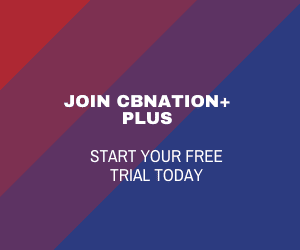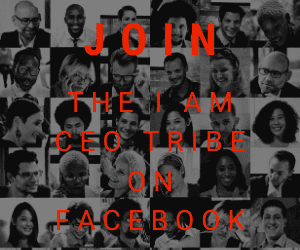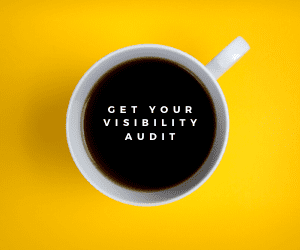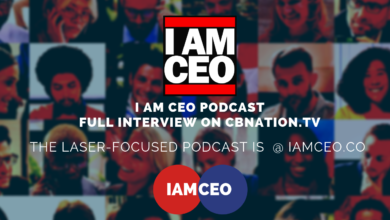Innovator and Author Enhances Cognitive Function through Neuroplasticity
Full Episode from I AM CEO Podcast - IAM2006


In a world driven by technological advancements and an ever-increasing emphasis on cognitive abilities, understanding how our brains function and finding ways to enhance our cognitive capabilities is crucial.
In this episode, we delve into the groundbreaking work of Barbara Arrowsmith-Young, an innovator in the field of neuro education, and explore the transformative power of neuroplasticity.
Barbara's journey into the world of neuroplasticity began with her own personal struggles. Born with significant learning difficulties, she embarked on a quest to find a solution that would address her unique challenges.
Guided by the belief instilled in her by her father – “If there's a problem and there's no solution, you have to go out and create that solution” – Barbara harnessed the power of neuroplasticity to not only improve her own cognitive functioning but also to help others facing similar difficulties.
Conclusion:
Barbara's work serves as a testament to the incredible potential of neuroplasticity. By harnessing the brain's ability to adapt and rewire itself, individuals facing learning difficulties, traumatic brain injuries, addiction, and cognitive decline can experience significant improvements in their cognitive functioning.
Through targeted interventions and a commitment to co-creation, Barbara and her team continue to pave the way for cognitive enhancement, offering hope and transforming lives.
Website: arrowsmith.ca
Check out our CEO Hack Buzz Newsletter–our premium newsletter with hacks and nuggets to level up your organization. Sign up HERE.
I AM CEO Handbook Volume 3 is HERE and it's FREE. Get your copy here: http://cbnation.co/iamceo3. Get the 100+ things that you can learn from 1600 business podcasts we recorded. Hear Gresh's story, learn the 16 business pillars from the podcast, find out about CBNation Architects and why you might be one and so much more. Did we mention it was FREE? Download it today!
Full Interview:
Transcription:
The full transcription is only available to CBNation Library Members. Sign up today!
Barbara Arrowsmith-Young Teaser 00:00
So then started working with some individuals with traumatic brain injury and seeing very similar changes. We do imaging research.
And yes, it is changing. And we see similar patterns. If you have a learning difficulty, or if you have acquired brain injury. There's a similar patterns of under-connectivity and hyper-connectivity. And as the individual goes through the program, those under-connected areas start to strengthen in their connectivity, which then frees up energy in the brain to become creative and function much more effectively.
Intro 00:31
Are you ready to hear business stories and learn effective ways to build relationships, generate sales, and level up your business from awesome CEOs, entrepreneurs, and founders without listening to a long, long, long interview?
If so, you've come to the right place. Gresh values your time and is ready to share with you the valuable info you're in search of. This is the I Am CEO Podcast.
Gresham Harkless 00:59
Hello, hello, hello. This is Gresh from the I Am CEO podcast. I have a very special guest on the show today. I have Barbara Arrowsmith-Young. Barbara, excited to have you on the show.
Barbara Arrowsmith-Young 01:08
I'm thrilled to be here.
Gresham Harkless 01:09
Thank you. Yes, absolutely. I'm thrilled to have you as well too. You're doing phenomenal things.
And what I want to do is just read a little bit more about some of those phenomenal things. So you can hear a little bit more about Barbara.
An innovator and an author in the field of neuroeducation. Barbara's work utilizing the principles of neuroplasticity is used worldwide to enhance cognitive functioning.
Her vision is to put the Brain in the Education Equation. Her work began in 1978 is recognized as one of the first examples of the practical application of neuroplasticity to address learning difficulties. And its application has expanded to address those dealing with traumatic brain injury, addiction, cognitive decline with aging and those who want to enhance performance.
Her journey and work is documented in her bestselling book, The Woman Who Changed Her Brain and in her TEDx talk as the director of the Arrowsmith program. Barbara continues to engage in research, to understand how we can drive neuroplastic change in the brain to benefit learners of all ages.
Barbara excited to have you on the show. One of the things that I wanted to mention is that you have to have to have to listen to her TEDx talk and how powerful transformation is. I think so many times we can get stuck in. This is how our brains work. This is how our lives work. But I love more than anything else.
I think that your story is phenomenal and that you've been able to remind us of how important transformation and changes and how it's definitely possible. And I had to pull two quotes that you said your dad reminded you of, which is, if there's a problem and there's no solution, you have to go out and create that solution.
And another thing he said before you solve a problem, you have to understand its nature. So absolutely love all the awesome things you're doing. Barbara, are you ready to speak to the I Am CEO community?
Barbara Arrowsmith-Young 02:46
I am. I'm really pumped. I'm really charged to speak community. Thank you.
[restrict paid=”true”]
Gresham Harkless 02:51
Yeah, I'm pumped as well too.
And so, I know I touched a little bit on your bio and your story. Could you take us through what I call your CEO story? That you get started with all the awesome work you're doing.
Barbara Arrowsmith-Young 03:00
It's interesting. I think probably my CEO story started at birth. If one believes in, I don't know, destiny or fate, obviously one has free will as well.
But, having been born with very, very significant learning difficulties that really set me on the, my path, when you're on a, an airplane and they say, if there's a problem, the lights will show up on the floor and guide you to safety. I feel from birth.
I had those lights guiding me to, to create this work. So it was both nature and nurture. The nature was being born with a brain that was not functioning in certain ways as it was designed to. And then the nurture was having my parents my father, who was an inventor and a scientist and had those beliefs that you talked about and the other piece of wisdom that he gave me said, if the rest of the world tells you, you can't do it.
He said, don't listen. He said, this is how science goes forward. So I had, my father setting me on a quest to find a solution to the difficulties I was born with. And my mother was an educator. And she believed in being of service. This was her big contribution of, taking your gifts and being of service in the world.
So I feel like, yes, my journey started very, very early. And then my schooling was, was a struggle all the way through school. It was never easy because of the learning difficulties. And also it was at a time when there wasn't even an understanding of learning difficulties because I started my schooling, in the mid to late 1950s.
So the term hadn't even been identified. So I, I experienced, a lot of, a lot of struggle. But with that message from both of my parents of being of service and finding a solution. So I feel I was set on a quest to, to create this work and it was very intentional.
So I feel like everything I did from the courses I picked in university, child development, to try to understand really what was wrong with me, and then school psychology, doing my master's degree really to try to understand the nature of my challenges, then understand what I could do about that and coming across lines of research that I put together.
And then when I saw the changes saying it's not sufficient that I benefited. I need to take this out into the world and find a way to have others benefit. And that's the origin of this work. So it's really very intentional, very purpose-driven, very visionary.
Gresham Harkless 05:28
Yeah, absolutely. And I feel like at the heart of entrepreneurship, especially it's about solving problems.
I don't know if you feel like in much of the same word purpose as well to those attention and purpose together, you start to have those experiences that you go through in life and they seem to like, for lack of a better term, arm you or prepare your end up being like instruments that you can use to be able to fulfill that intention and fulfill that purpose and all of those things.
So it's sound like you may have had that experience.
Barbara Arrowsmith-Young 05:53
Absolutely. So I would agree purpose. I think somebody asked me to describe my organization. We're visionary and purpose-driven. Anybody that comes to the work is driven by a purpose of wanting a really fundamental level, making the world a better place.
It sounds trite, but that is fundamentally what drives us because, with cognitive enhancement, we open possibilities for humanity, like for individuals, if they're struggling with learning difficulties, if we change their brain, all sorts of doors open that weren't open before we work with people with addiction, that opens all sorts of possibilities to, a different trajectory in their life, people with traumatic brain injury and just, regular individuals anybody can enhance cognition.
Gresham Harkless 06:37
So I want to drill down a little bit more here, a little bit more on how you're serving the clients that you work with. I know you mentioned a little bit about your mission and needing that purpose. But could you take us through a little bit more on what that looks like and how you're making that impact?
Barbara Arrowsmith-Young 06:48
Yeah, so it's starting with listening very deeply to the needs of the clients that we're working with, right? It's again, like not making an assumption that I think I know what they need. And then extending what we were offering to meet those needs, right? Fundamentally our, what we offer, our secret sauce is changing the brain.
And changing the brain in multiple cognitive functions. I, I created programs, I had Multiple learning difficulties. So I couldn't just create one program. I created three different programs for three different parts of my brain, saw the transformation, and now we have programs for 19 different regions.
So again, it's been listening to people would walk through the door of my first office here in Toronto and Canada, and they wouldn't have the same difficulties I had. So I had to listen very deeply as they described the challenges that they were experiencing in their lives. Go back into the neuroscience literature, do a lot of reading, trying to figure out, okay, is what they're describing, this part of the brain, is it this cognitive function?
Then come back to them, continue the conversation then try to create something that I think would stimulate that cognitive function. So it's really, if you understand the nature of the brain, Part of the brain or the function that it does, you can create an activity or a task that works. It just if you're going to physiotherapy and you have a very specific muscle group.
That's injured. You're going to be exercising, that muscle group or the muscles around it. So it's identifying the cognitive function, creating a task and then applying it to see is it actually improving that part of the brain or that functioning. And that's where sometimes things I ended up in the garbage pail because they didn't do what I thought, but it really started with, being grounded in science, but deeply listening to the client's experiences, their needs, and it was, I describe it almost like a series of naturalistic experiments.
It was really exciting because it was very innovative, very creative, and over time, that led to the creation of the 19 programs, and I'm very clear that the brain is more complex than that. There are more regions, but, we have programs to address, things like thinking, reasoning, planning, problem solving, spatial ability, mechanical reasoning, auditory memory, visual memory face recognition All sorts of really critical functions that we can take the person from where they're currently holding, whether it's a difficulty or average functioning or even above average functioning, and we can enhance that and strengthen it and improve it.
And then I started thinking, okay, we have this, these set of exercises, we're applying it currently to students with that are struggling with learning, learning challenges. Is can I expand that beyond just individuals? Not just. I was one of those individuals with learning difficulties. So we started thinking, okay, what are other applications given our brain is central to everything we do?
So then started working with some individuals with traumatic brain injury and seeing very similar changes. We do imaging research. We work with. Universities to do research because I'm very solid around evidence base. That, we make a hypothesis that the brain is changing, but we actually need to look into the brain with to see.
And yes, it is changing. And we see similar patterns. If you have a learning difficulty, or if you have acquired brain injury. There's a similar patterns of under-connectivity and hyper-connectivity. And as the individual goes through the program, those under-connected areas start to strengthen in their connectivity, which then frees up energy in the brain to become creative and function much more effectively.
So it was then going out and exploring, what other applications are there. So we started with People with acquired or traumatic brain injury we started then looking at individuals just in regular classrooms, mainstream classrooms, because you go to school to learn, you learn with your brain let's enhance the brain, right?
So again, it's really, for me, it's seeing possibilities. It's it's going out there. You've got a product, and what are the range of possibilities where that product will add value? To the world. And for me, our product is cognitive enhancement, changing the brain, and then looking at what are all the different applications.
Gresham Harkless 11:09
I love that. So I truly, appreciate, all of that. So I wanted to switch gears a little bit, and I wanted to ask you for what I call a CEO hack. So this could be like an Apple book or a habit that you have, but what's something that makes you more effective and efficient.
Barbara Arrowsmith-Young 11:23
Yeah, I'd say there are a couple of things.
I read many, many years ago that book, E Myth, which had a huge, oh my gosh, that was like had a huge impact on me, right? Because I thought, okay because at that point I was doing everything, right? And I thought, okay, if I want this work to scale and to, I have to leverage myself, right?
I have to create an organization, that people can do, that I'm replaceable, right? So that, that was I would say any entrepreneur starting out, I know it's. It's, an older book, but it's very, very powerful. So I would recommend that. And the other thing for me is creating what I call drift time or big picture time.
For me, it's gardening. Some people might be meditation. Some people might be going for a walk. I need time where any problem that I'm dealing with, I just, I park it in the back of my brain. I just, and I go out, and for me, I garden, and just being, out there, it's very meditative, and I'm just at one with nature, and with whatever I'm doing in the garden.
And what I often find is, unbeknownst to me, that problem gets solved because something is happening in that drift time, that big picture time, and it often, the solution is much better than if I'd spent two or three hours thinking about the problem. So I can't function without what I call that drift time.
So I would encourage any entrepreneur to create space in their day to just have that. Drift time or that open, I don't know what else to call it. Dream time, maybe in the aboriginal language. I find it I couldn't function without it. So those are my 2 recommendations.
And I guess the 3rd 1, I know you only asked for 1 is, creating an environment, in your organization where. Everybody feels safe and everybody feels that all voices are welcome, right? Because I don't care if it's my receptionist it doesn't matter who it is.
So it's really creating a safe space where. Everyone's thoughts and ideas are welcome because it's not all up to me to come up with the ideas and sometimes someone will come up with a better idea than I had and it doesn't matter who that is in the organization, but there has to be a safe space where people feel that that they can contribute and that is welcome and it's not going to be judged.
Gresham Harkless 13:47
Yeah, I absolutely love that.
So, I went to ask you now for what I call a CEO nugget. This is a little bit more word of wisdom or piece of advice. It could be something that you might tell a client, something from your book, or if you were to hop into a time machine, you might tell your younger business self.
Barbara Arrowsmith-Young 14:01
Yeah, it's a really interesting question.
I think for me, the stay true to your purpose, I think that's really important because they're, or stick to your knitting. That's a, an old expression. There are lots of times where I've had people come to me and say, oh, what about this over here? And I'm not suggesting that it isn't interesting, but it's not aligned with.
The purpose of the organization, and it would be a distraction and take us down a different path that isn't really our purpose or our intention. So, yeah, I've learned, and maybe there are a couple of times where I have been distracted and, started down that path and then it's not been where we need to go.
So I think it's, yeah, really be clear on your purpose and align with your purpose and evaluate everything that comes your way. Is it aligned or is it not? And then do I want to really go into a different business or am I wanting to really stick with what my purpose is?
Gresham Harkless 14:57
Yeah, I love that.
So what would you consider to be your answer to my absolute favorite question, which is the definition of what it means to be a CEO. My goal is to have different quote-unquote CEOs on the show. So Barbara, what does being a CEO mean to you?
Barbara Arrowsmith-Young 15:08
I think I would go back to what I said earlier. To me, being a CEO is creating a safe container where all voices are welcome, that we're co-creating, we're co-creating together again, aligned with whatever the purpose of the organization. But creating that my role, I see is creating that safe container where ideas can come forward, get incubated and developed that are aligned with our purpose.
Gresham Harkless 15:35
I love that. So thank you so much for that co-creation opportunity, Barbara. And of course, I appreciate your time even more. So what I want to do now is pass you the mic, so to speak, just to see if there's anything additional that you can let our readers and listeners know.
And of course, how best they can get all of you, your team, get a copy of your book, find out about all the awesome things you're doing. And of course, listen to that TEDx talk.
Barbara Arrowsmith-Young 15:56
Yeah, so everything is on our website is arrowsmith.ca and just a little aside. I. was my father's mother's maiden name, and she was a pioneer.
So, I'm honored that I have that name and I put that name to the work, but yeah, arrowsmith.ca there's a wealth of resources we've got webinars on the brain.
Gresham Harkless 16:16
Awesome. Awesome. Awesome. To make it even easier. We're gonna have the links and information in the show notes as well, too.
So thank you so much for embodying that. Of course, your time today. And I hope you have a phenomenal rest of the day.
Barbara Arrowsmith-Young 16:25
Thank you so much.
Outro 16:26
Thank you for listening to the I Am CEO Podcast powered by CB Nation and Blue 16 Media.
Tune in next time and visit us at iamceo.co. I Am CEO is not just a phrase, it's a community.
Don't forget to schedule your complimentary digital marketing consultation at blue16media.com. This has been the I Am CEO podcast with Gresham Harless, Jr. Thank you for listening.
[/restrict]




